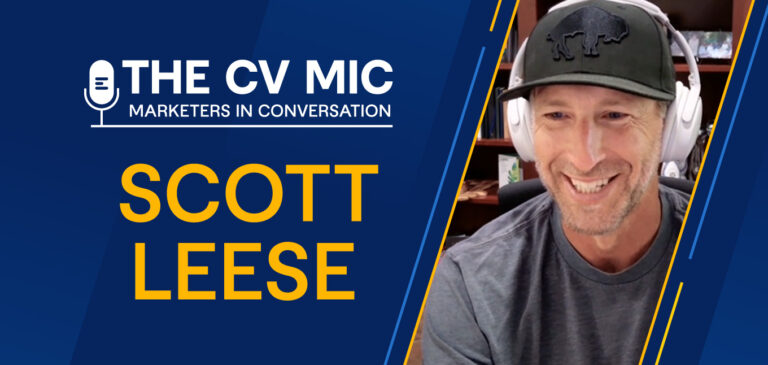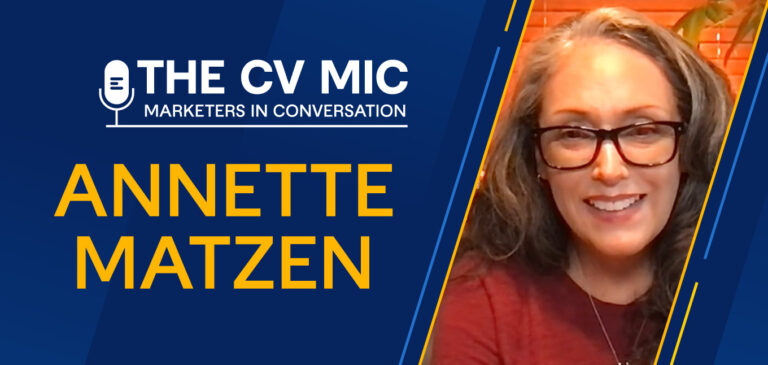When you’ve built and scaled sales teams for two decades, with multiple nine-figure exits along the way, you see patterns. You know the mistakes that slow teams down, the shifts that create momentum, and the structural decisions that separate thriving revenue organizations from those constantly scrambling.
Scott Leese has spent his career helping companies — especially early-stage startups — go from zero to $100M with strategies rooted in focus, process, and alignment. In this CV MIC conversation, he shared how sales and marketing leaders can work together toward one unified revenue motion.
Narrow Your ICP; Then Narrow It Again
One of Scott’s first moves when consulting with an early-stage company is to zoom in on their ideal customer profile (ICP).
Most startups cast the net far too wide. They list multiple industries, target companies of vastly different sizes, and assume the same sales motion can work for a small local firm and a Fortune 500 enterprise. It rarely does.
In Scott’s view, the broader your ICP, the harder it is to build momentum. Larger accounts often require long, complex sales cycles that can stall early growth. Smaller, easier-to-reach accounts give you a chance to refine your pitch, test your messaging, and generate wins quickly. Those early deals become the foundation for moving upmarket later.
His advice: start where you can win fast and often, even if it’s not your dream client. The practice you get closing those “smaller” deals builds the muscle you’ll need for bigger, more complex opportunities.
Document Everything… Because You’ll Need It
In the early days, it’s common for processes to live in someone’s head or in a scattered collection of notes. But when nothing is documented, onboarding slows, mistakes repeat, and no one can clearly see what’s working.
Scott pushes teams to document everything:
- Which channels are bringing in quality conversations
- Messaging that resonates (and messaging that flops)
- Sales processes from outreach to close
- Pricing structures and discount policies
- Win/loss insights
The goal isn’t to create a rigid playbook that never changes — it’s to create a foundation that can evolve. Clear documentation allows new hires to ramp quickly, helps teams spot trends, and makes it easier to scale without losing consistency.
Hire for the Stage You’re In
Many early-stage founders assume a “big name” hire will be a silver bullet. Scott’s seen the opposite. Bringing in someone who’s only worked at a large, well-known brand — with abundant inbound leads and a recognized name to open doors — often backfires in a scrappy startup environment.
Early hires need a different skill set: resilience, comfort with ambiguity, and the ability to build from scratch without a fully formed infrastructure. These are the people who can thrive without the safety net of a well-established brand and still find creative ways to generate pipeline.
Stage-appropriate hiring means looking for candidates who have already operated in the kind of environment you’re in now, not the one you hope to be in five years.
Align on One Goal (and Drop the Attribution Battles)
Scott’s philosophy on sales-marketing alignment is simple: one shared goal tied directly to revenue.
When each department is measured on separate metrics — marketing on MQLs or SQLs, sales on closed deals — the result is often finger-pointing over attribution. That internal friction wastes time and energy.
By giving both teams a shared revenue target, everyone’s incentives align. One quarter, marketing might generate most of the momentum; the next, sales might carry the load. What matters is the win, not who “scored.”
Speak the Same Language at the Right Time
Marketing and sales use different styles of communication. Marketing content is often designed to inspire or educate, while sales outreach is more direct and action-oriented. Problems arise when those styles are used in the wrong contexts, or when both teams aren’t aligned on which pain points actually drive conversions.
Scott encourages regular meetings between sales and marketing leaders to compare field feedback and adjust messaging. If sales is consistently closing deals based on one pain point, marketing needs to amplify it in campaigns. If marketing sees an emerging theme in the market, sales should know how to work it into conversations.
When both teams are speaking to the same priorities in the right style for the channel, the buyer experience feels seamless.
Use AI for Insight, Not Autopilot
AI tools can be invaluable for research, call analysis, and coaching. Scott points to AI coaching platforms as a way to solve two common complaints: sales reps don’t get enough coaching, and sales managers don’t have enough time to provide it.
But there’s a caution: over-reliance on AI leads to surface-level execution without true understanding. AI can give you a starting point, whether it’s summarizing a prospect’s LinkedIn activity or drafting an email outline, but you still need to apply human judgment, context, and creativity before hitting send.
Stand Out with Unscalable, Human Touches
In a world where automation is everywhere, genuine human gestures cut through the noise. Scott shared examples of creative outreach — like sending two business partners tickets to a Cubs-White Sox game so they’d have uninterrupted time to discuss a deal.
These moments are memorable because they’re tailored, thoughtful, and impossible to mass-produce. Within the boundaries of your industry’s compliance rules, a mix of personalized gifts, direct mail, and face-to-face meetings can turn cold leads into warm conversations faster than another generic email blast.
Build Your Network Like It’s Pipeline
Scott calls it the “go-to-network” motion: using personal connections to open doors faster, at lower cost, and with higher trust.
A strong personal network doesn’t just make prospecting easier — it also gives salespeople a competitive edge in the job market. Given two equally qualified candidates, the one with a larger, engaged network will almost always get the nod.
For reps hesitant to post content, Scott suggests starting with connection requests. Add 15-20 relevant contacts a day. Over time, conversations will spark, comments will follow, and creating original posts will feel like a natural next step.
The Bottom Line
Scott’s parting advice is straightforward:
Stay creative in your outreach, keep communication lines open between teams, and never stop learning. The sales and marketing landscape is evolving faster than ever, and the organizations that adapt together will win together.
Connect with Scott via Scott Leese Consulting or give him a follow on LinkedIn.
Want to connect your marketing and sales teams around one revenue motion? Connect with a ClearVoice content strategist about building messaging, content, and workflows that actually drive revenue.
Catch More CV MIC Conversations
If you found Scott’s insights valuable, don’t miss these other episodes:







